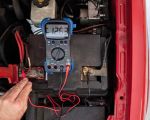How to Test a Car Battery Before Replacing It
If you're experiencing issues with your car starting, it’s natural to think the battery is the culprit. However, before you rush to replace your car battery, it's essential to test its health first. A simple test can save you money, as well as time spent on unnecessary repairs. In this guide, I'll walk you through how to test a car battery before deciding to replace it, using practical steps and techniques to ensure that you make the right decision.

NTB-National Tire & Battery
6315 Prentiss School Dr, Canal Winchester, OH 43110, USA
1. Check the Age of Your Battery
The first step in diagnosing your battery is determining its age. Most car batteries last between 3 to 5 years, depending on the climate and usage. If your battery is older than this range, it may be time to consider replacing it. However, just because the battery is old doesn't automatically mean it’s dead, so we need to run some tests.

Pep Boys
1200 W Washington Blvd, Los Angeles, CA 90007, USA
2. Visual Inspection
Before diving into any technical tests, start with a simple visual inspection. Look for any obvious signs of damage. Here are some things to check:
- Corrosion: Check the battery terminals for any corrosion, which can prevent the battery from charging properly. Corrosion is often white or greenish and may spread to the cables.
- Leaks: Look for any battery fluid leaking from the cells. If you spot a leak, it’s time to replace the battery as it’s unlikely to function properly.
- Cracks: Check for any cracks or damage to the battery case. Physical damage often signifies that the battery needs to be replaced.
3. Check the Battery Voltage
Once you've performed a visual inspection, the next step is to check the battery voltage. You can do this using a voltmeter or a multimeter, which is a common tool used to measure electrical current in your car. Here’s how you can do it:
- Turn off your car and all accessories like lights or air conditioning.
- Set your multimeter to DC voltage and select the 20V range.
- Place the positive (red) probe on the battery’s positive terminal and the negative (black) probe on the negative terminal.
- Read the voltage on your multimeter. A fully charged battery should read between 12.6 to 12.8 volts.
- If the reading is below 12.4 volts, it’s an indication that your battery may be undercharged or starting to fail.
4. Perform a Load Test
While the voltage test gives you an initial reading, it doesn’t test the battery under load, which is how it performs when your car is running. To conduct a load test, you can either do this yourself or have it done at an auto parts store or mechanic. Here's how you can perform a load test at home:
- Start the car and let it idle for a few minutes to ensure the battery is fully charged.
- Turn on the headlights and accessories such as the radio to simulate load on the battery.
- Using your multimeter, measure the voltage again with the car running. The voltage should drop but stay above 13.5 volts. If the voltage falls significantly below this, it’s a sign that the alternator or the battery itself might be faulty.
If the voltage drops below 12.4 volts during this test, the battery is likely struggling to maintain charge and should be replaced.
5. Check the Alternator
If you’ve tested the battery and found it to be undercharged or failing, it could be due to an issue with the alternator rather than the battery itself. The alternator charges the battery while the engine is running, and a failing alternator could lead to a dead battery.
To check if the alternator is working properly, measure the battery voltage with the car running. If the voltage is below 13.5 volts or above 14.5 volts, this suggests that the alternator is not functioning as it should. In such cases, you should have your alternator inspected or replaced by a professional.
6. Test the Battery’s Charge Capacity
Another test you can perform is to check the battery's charge capacity. This test requires a specific tool known as a “battery load tester,” which you can purchase at an auto parts store or borrow from a mechanic. The load tester simulates the electrical demands your car places on the battery and helps determine whether the battery can hold a charge under load.
- Disconnect the battery cables before attaching the tester to the battery terminals.
- Attach the load tester according to the manufacturer’s instructions.
- Activate the load tester and observe the reading on the device. If the tester shows that the battery can’t maintain a certain load or voltage, it’s likely that the battery has gone bad and should be replaced.
7. Using Professional Help
If you’re unsure about performing these tests yourself or if you don’t have access to the necessary tools, don’t hesitate to take your car to a professional. Many auto parts stores offer free battery testing services. A technician will be able to run comprehensive tests and provide you with a clear diagnosis of your battery's health.
When testing your car battery, it's important to understand that several factors can influence its health, such as extreme temperatures, driving habits, and even the age of the battery. By regularly checking your battery, you can prevent unexpected breakdowns and ensure that your car’s electrical system is functioning efficiently.


























